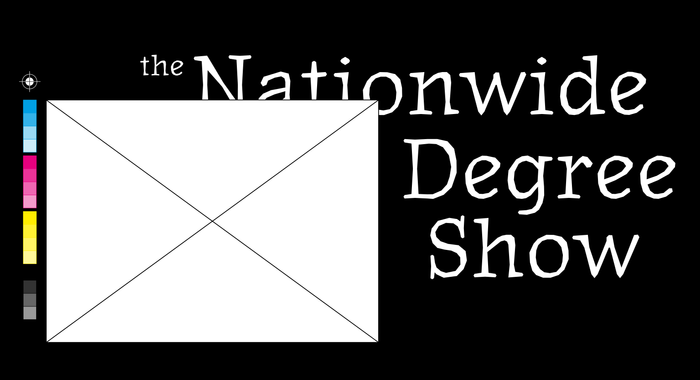Nationwide Degree Show: Vitamin London Curation
The Nationwide Degree Show is a collection of work from art & design students, who's final year shows have been cancelled due to COVID19. What started as an initiative by Fresh Meet to plaster billboards across the UK with student work, has now resulted in an online collection of over 1000 submissions from over 100 universities and 17 creative disciplines. The Curation Series is a programme of student work selected by industry leaders, creative pioneers and trendsetters. Below you will find a selection of student work curated by Vitamin London Founder & Creative Director, Jacob Beckett and Art Director, Robert Lloyd.
Vitamin London is a digital innovation studio who partner with ambitious companies to build human solutions. With a small, progressive and dedicated team, Vitamin help clients ranging from start-ups to blue chips with a vast array of work from brand strategy, digital & production
Selecting their curation across all disciplines within the submissions, Robert Lloyd comments "Innovation has legitimately come where we've least suspected it."
#1 - Harry Wakefield
The first selected piece in this curation is a custom typeface by Harry Wakefield
Vitamin writes, "A layman might think that a font is merely a selection of letters whose forms are “easy to design”. This project however goes to demonstrate the delightful backstories which can be embedded, the unexpected physical origins of a digital solution, and the way in which fonts are vital in capturing an era in history. Bringing all these aspects to a head has resulted in an excitingly innovative approach to type design."
Harry Wakefield at Manchester School of Art
Harry writes "During this brief I was asked to create something that showed where my inspiration derives from. I have always loved making objects and looking at buildings that for some may be ‘unattractive’. Being heavily inspired by post war modernism, this typeface is inspired by some of my favourite brutalist buildings in London, my home.
'BRUTAL LONDON' follows a strict grid system in the form of harsh blocks and thin crevasses where windows would typically be found in these buildings.."
#2 - Linzi MacLaren
The next selected piece in this curation is a textile design by Linzi Maclaren.
Vitamin writes, "Opening eyes to a whole new approach to fashion, this project finds itself under a category of textiles after having passed through what could easily be considered both art and photography. Using a clever metaphor where desirable items decay and are then brought back to an abstracted form of hand-crafted beauty brings a innovative statement to a huge global issue."
Linzi Mclaran, Textile Design at Duncan of Jordanstone College of Art and Design.
Linzi writes "To combat fast fashion, I am challenging stereotypes of beauty by finding the allure in what we may usually deem repulsive. I have developed imagery from decaying raspberries to create timeless and handcrafted Textile pieces to be cherished. Like fast fashion, this raspberry has gone out of date, but by finding the beauty within it I want to show that fashion should have no expiry date."
#3 - Kevin
The next selected piece in this curation is product design by Kevin.
Vitamin writes, "“Homeless” is an excellent example of innovation for the good of society. Where a bird box alone might not be revolutionary, the consideration to an issue which many will be oblivious to, combined with accessible resources, has elevated a familiar piece of design to support its surroundings in exciting new ways."
Kevin, Graphic Design at Kingston University.
Kevin writes "Homeless people do not have an address which hinders them from accessing the services they need.
In London, 700,000 trees have been given an address in the form of longitude and latitude. By using What.3.Words, an application that translates coordinates to 3-word addresses, it enables trees to have addresses.
Birdposts are attached to these trees and give the homeless a temporary address to receive mail."
#4 - Irvin Tam
The fourth selected piece in this curation is a product concept by Irvin Tam.
Vitamin writes, "Although this might have been created prior to life in lockdown, the self-care incentive of Ceres strikes as being more poignant than ever. Connecting emotions, health, proactivity, digital and the physical experiences all together under one elegant solution is no easy feat and an innovative way to promote well being through product design."
Irvin Tam from Kingston University.
Irvin writes "Ceres is a speculative device that connects people with nature in response to contemporary society's technology addiction and detachment from reality. The users' health-related habits, including their amount of time spent on mobile devices, step count and hydration, are connected to the necessities of the plant provided by the device."
#5 - Megan Hamilton
The next selected piece in this curation is jewellery design by Megan Hamilton
Vitamin writes, "Riding a rightfully important wave against natural pollution, fast fashion and for sustainability, this artist has innovation written all over her approach to jewellery. Taking so many careful considerations to material, form and function, her results are not only fascinating but inspiring to how jewellery can be used in the industry and in culture."
Megan Hamilton, Ceramics, Jewellery and Silversmithing at Ulster University
Megan writes "I am a “sweet tooth silversmith” creating jewellery to help heal the world’s cavities. One area is single use plastics and overall plastic pollution. To combat this catastrophic effect on our environment, focusing on the ocean landscape, I developed an innovative bioplastic, utilising sweets. This material is completely biodegradable yet strong and versatile. Along with inspiration from the plastic crisis, I was inspired to create a circular design collection based on the idea of lost jewellery found lying on the ground. Being biodegradable, if my jewellery were to fall on the ground it would completely breakdown and return back into the earth, thus is assisting in contributing to solving the pollution problem.
Along with the “Sweet Bioplastic” I created, I was conscious of the material choices within the pieces. For the items that incorporated metal I used Eco-Silver, which is made from 100% recycled and scrap silver products thus environmentally friendly. By combining science and craftsmanship I wanted to create items to help, not hinder the world around us through the use and reuse of sustainable materials."
#6 - Charlotte Key
The next selected piece in this curation is a braille childrens book collection by Charlotte Key
Vitamin writes, "Seeing an abundance of progressive visual trends, it’s wholeheartedly refreshing for an idea to take shape through such a carefully reduce application of storytelling and structure. Where visuals are secondary and function take precedence, the innovative use of materials, hierarchy and accessibility result in an inspiring solution which anyone can appreciate."
Charlotte Key, Graphic Design at Nottingham Trent University
Charlotte writes "A Braille children's book collection, about inspirational blind people and their carers. Braille is important for blind children as it teaches them vital literacy skills such as spelling, punctuation and grammer which audiobooks can not teach. This is a photo from A for Astronomy, focusing on Nic Bonne a visually impaired astronomer. The book is printed in both Braille and text, with tactile illustrations throughout."
#7 - Anna Page
The next selected piece in this curation is a collection by Anna Page.
Vitamin writes, "Using a raw medium to tell a story can be a challenge for most, as it is in effect a blank canvas, but in this piece the absence of detail speaks volumes to a large scale issue. In contrast, innovative the application of colour, shape, and pattern both breathes life into the works and also highlights the lack thereof, providing a genuinely unexpected moment to pause and reflect on an inspiring level of craftsmanship and messaging."
Anna Page, Decorative Arts at Nottingham Trent
Anna writes "My work is driven by my passion to raise awareness of coral bleaching happening across the world. My work is tactile, beautiful and educational. It evokes strong feelings of responsibility and melancholy whilst living as beautiful installation art. My final collection will be an installation of 300 unique corals which can be displayed together or in isolation. This photo shows a few of my sample pieces displayed together to give an impression of how my final collection will look."
#8 - Chloe Turner
The next selected piece in this curation is a poster design by Chloe Turner.
Vitamin writes, "Both reacting into its surroundings and mixing unpredictable aesthetics with substantiated facts, this is a piece of work which has the power to capture a viewer’s attention multiple ways. With a bold cropped title for you to join the dots on, the innovative use of ink allows the design to either remain understated or adapt to the environment with increasingly ominous glimpses to fact’s which many refuse to face."
Chloe Turner at Norwich University of the Arts.
Chloe writes "Using thermochromic inks to visualise the impact of global warming a poster was screen printed to reveals facts and figures about the growing climate crisis. The process of printing the poster was also recorded and turned into a supporting film. The aim of the posters is to raise awareness about global warming and climate change."
#9 - George Stockley
The next selected piece in this curation is a print design by George Stockley.
Vitamin writes, "Where design is encouraged to be increasingly sustainable, a powerful message can still be sent through its destruction. Tackling the lesser appreciated issue of coastal erosion, this piece of printed graphic design makes it’s statement through non traditional means; innovatively visualising the irreversible effects of your interactions while still resulting in a well considered piece of aesthetic design."
George Stockley Graphic Design at University for the Creative Arts
George writes "Climate change is affecting everyone's lives, yet people still do not believe it is happening or even exists. This project shows coastal erosion. The more you use the book, pages start to erode away, just like the coastline.
SEA books case study is the Isle of Wight - my and collaborative photographer @ben hometown - as here climate change has obvious and harsh effects on the coastline.
With everything that is happening at this moment in time, there has been a glimmer of light in which the climate has proved it can heal. We must be mindful of this as we come out of isolation someday in the future."
#10 - Emily James
The next selected piece in this curation is a product collection by Emily James.
Vitamin writes, "Looking to provide a child friendly space while not playing to overt tropes, this piece of textile design inspires innovation with a thorough consideration to tactile, aesthetic and diverse experiences. The notes towards children’s imaginations and natural environments, while still maintaining a mature overall feel, has resulted in a wonderfully innovative way to support those with mental health issues at young ages."
Emily James, Textile Design at Nottingham Trent University.
Emily writes "Daydream is a collection of products designed to create a calming room for young children who are suffering from mental health issues. An environment for children, where everyday distractions are removed, and relaxation and concentration is encouraged. With the use of calming colours, imagery and tactile embroidery, Daydream creates a road to a mental escape in a safe and secure environment. With inspiration drawn from nature and the wild imaginations of children, the collection has a sophisticated yet childlike quality. The mood is exciting yet calming, filled with colourful and innocent imagery designed to provoke the need to express their thoughts and feelings."
#11 - Hannah Carlile, Charlie Sanderson & Will Butterfield
The next selected piece in this curation is a group piece by students: Hannah Carlile, Charlie Sanderson & Will Butterfield.
Vitamin writes, "As many solutions bring about a direct solution, innovation can also be found in a response so outlandish that it changes perceptions from then on. By perpetuating the awkwardness of C&Cs to abstraction until they are redundant, the idea holds a great creative balance between memorable impact and habit awareness."
Hannah Carlile, Charlie Sanderson & Will Butterfield, Graphic Design at Kingston University.
The trio write "Small Print
97% of people don’t read terms and conditions - they are discrete and made difficult to access by their physical scale and use of unfamiliar legal language. We decided to make T&C’s really really big, so big in fact that they are equally as awkward to read.
We increased the original size of The London Eye terms and conditions by 769 times. From ground level, they cannot be read in their hugely awkward scale. Only by riding in the capsule can you begin to make sense of them, by which point they’ve already been accepted."
#12 - Francesca Rea
The next selected piece in this curation is this textile design by Francesca Rea.
Vitamin writes, "A typical trait for contemporary influential design is to build on longevity; instead this brings a fresh perspective of clothes made for death. Retaining an eco friendly, handcrafted foundation, the inspiring layers of thought towards cultural impact and semantic themes - coming together as beautiful results - open candid conversations around how textile design can innovate in all areas of life."
Francesca Rea, Textile Design at University of Dundee.
Francesca writes "Textiles hold great significance across cultures and throughout history, and what one wears in the grave is a meaningful decision for many people. My project aims to open the discussion around death and the rituals and practices that surround it. Using the slow and thoughtful process of hand embroidery, I have designed textiles for burial-wear made from animal and plant-based fabrics and natural dyes that are 100% decomposable. I have drawn from disintegrated leaves as a reminder of our place in the environment, one that we must look after for the next generations in the cycle of life."
#13 - Jennifer Lynch
The next selected piece in this curation is a textile design by Jennifer Lynch.
Vitamin writes "As creativity is omnipresent, cross-pollination of ideas from different disciplines allows for an exciting yet natural evolution in work. This is embroidery artist is no exception, with a delicate eye to photographing their surroundings and capturing even the slightest traits in a wholly new medium. Such a method creates an innovative set of patterns, textures and applications that may in turn inspire other disciplines."
Jennifer Lynch, Textile Art Design and Fashion and Placement at Ulster University, Belfast School of Art.
Jennifer writes "I am an Embroidery Textile Designer/Sampler that specializes in creating bespoke designs with structural and abstract elements suitable for high-end interiors and/or industrial spaces.
I have always been fascinated in finding patterns within the shapes and structures found in urban landscapes and in everyday life which I then capture through the lens of my camera, searching for the finer details that others may disregard. To creating both simple and complex designs, with a diverse range of ideas making each piece unique with a personal touch."
#14 - Becca Fuller
The next selected piece in this curation isa conceptual NHS campaign by Becca Fuller.
Vitamin writes "Given the topic’s relevance in recent events, this is an innovative use of juxtaposition where specialist information is combined against cheep’n’cheerful executions for both humour and impact. Further evolving this structure - and beneath the thin veil of education - the campaign brings everything into a tangible, and dauntingly familiar execution which feels much more real to viewers."
Becca Fuller, Graphic Design at Leeds Art University.
Becca writes "This campaign is based on instructions that demonstrate how to perform surgeries
demonstrating a low budget option of healthcare if it was to become privatised. Styled as IKEA instructions as IKEA is the low budget of furniture. These instructions are supported by posters which explains how you can stop the instructions becoming a reality."
#15 - Sophie Gwilt & Annabel Dowd
The final selected piece in this curation is a series of print ads by Sophie Gwilt & Annabel Dowd.
Vitamin writes "Creativity must almost always work to constraints, and effective solutions often work with those boundaries as opposed to against them. Although the visual representation could be honed to better express the idea - the idea itself is wonderfully innovative. Repurposing an accessible service to legitimately help those suffering, as well as provide a reliable resource to their carers, this is an inspiring example of problem solving."
Sophie Gwilt & Annabel Dowd, The University of Central Lancashire.
On their work, they write "Every 3 seconds someone in the world develops dementia. More than 82% of people in the UK living with dementia are cared for by ‘informal carers’ who often have little or no training, and have no funding. Research has found that music therapy significantly reduces levels of stress and agitation as well as helping to recall lost memories. Using Spotify’s huge music library, we will re-position the brand to be a music therapy support service to help with dementia, and fight the disease through the love of music. These print adverts are to target informal carers letting them know about the service, whilst also with two of the OOH adverts creating awareness too!"


